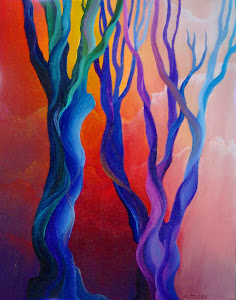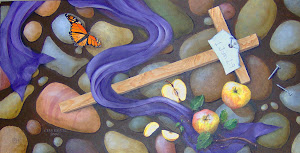She modestly draws back and responds, "ECCE ANCILLA DÑI." or "Behold the handmaiden of the Lord".

"Van Eyck is considered one of the greatest painters of any period. Advances in oil techniques helped him paint the physical world in minute detail and with a degree of realism never before possible. It was said he knew fabrics like a weaver, buildings like an architect, and plants like a botanist. Here it is hard to believe that the angel's gleaming brocade is yellow pigment, not true gold, "woven" with brushstrokes, not threads.
In this painting Gabriel announces to Mary that she will bear the son of God. She modestly draws back and responds, "Behold the handmaiden of the Lord." Her words are printed upside down for the Lord above to see. The Holy Spirit descends to her on seven rays of light. This is the moment God's plan for salvation is set in motion. Through Christ's human incarnation the old era of the Law is transformed into a new era of Grace.
Almost every element in the painting contributes to this theme. The architecture moves from older, round Romanesque forms to pointed Gothic arches. In the floor tiles, scenes from the Old Testament prefigure New Testament events; David's slaying of Goliath, for example, fore tends Christ's triumph over the devil. The single top window, where Jehovah stands, contrasts the triple windows below, which suggest the Christian trinity. Even Mary's overlarge figure inside the chapel operates symbolically to underscore her identification with the Church. The lilies beside her refer to her purity."
-from The National Gallery of Art
Van Eyck is one of my favorite painters, not only for his command of the paint and his magnificent attention to detail, but also for his imagery and symbolism. To view one of his paintings is to peel an onion, to contemplate each layer respectively. The more you learn about the symbolic nature of the objects and the setting the artist chose, the more beauty is revealed. My favorite painting by Van Eyck is The Arnolfini Wedding, which is exhibited at the National Gallery of London.
He, and his contemporary Northern European artists, are credited with introducing and perfecting painting with oils at a time when the Italian Renaissance artists were dedicated to fresco techniques. It is amazing the difference between the art of northern and southern Europe during this time. the contributions by both are amazing, yet so different in character.
Back to the Annunciation, if you wish to delve more deeply into the symbolism Van Eyck incorporated into this painting, may I suggest this site: Annunciation at Wikipedia
There are so many beautiful pieces of religious themed art from the past and present, but at Christmas time, or more properly Advent, with its focus on Mary and Joseph and their struggles as the awaited birth approaches, this particular painting touches me. The holiness and quietude of the scene enables me to reflect on the approaching miracle. The miracle of that one, world-changing birth in Bethlehem.








1 comment:
Thank you for that lovely post. Something to ponder during these dark days before Christmas.
Post a Comment